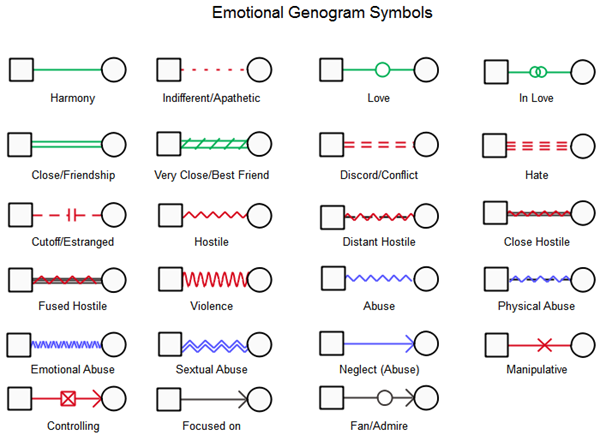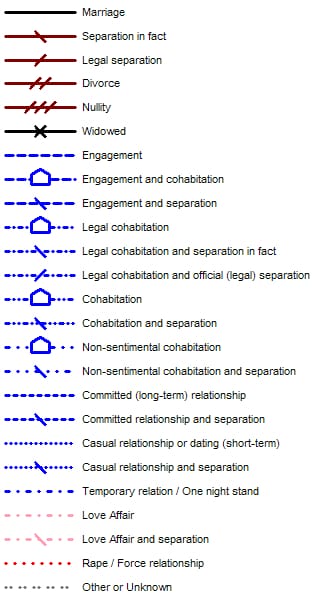
In working with clients it has been most successful for them to see where they have gotten their beliefs and biases through using the genogram. Using the links at the end of the article you can see the symbols and learn more about using genograms. Here is an example of one spouse’s genogram from the sample couple used in the class. Clients can be asked if there are any financial stressors that they see in previous generations or with their children and grandchildren. Some of the financial themes that can be traced through patterns in the family map are: bankruptcy, divorce, spending habits, money for college, weddings, home ownership, inheritance, drug use and abuse, health issues, etc. I use a green line for those who were positive financial connections, and a red line for those who negatively influenced their financial beliefs. I have them draw direct lines to the people who influenced them the most in their financial beliefs and values. Addiction, and mental or physical illnesses can be added, all of which have specific ways to show this visually. They will add the type of connections they have with their family members close, strained, hostile, fused, etc. Next we begin talking about relationships. Clients begin filling in information for their immediate family, then extended family on the genogram, and can add in any close friends that are highly influence them. The diagram starts with circles (women) and squares (men) as you have seen in family trees depicting the make-up of their immediate family. The genogram can be completed when a client begins with you, and then later to see how things have changed. A genogram is a point in time tool, showing where the key person is at the point in time that they are completing the diagram. Clients seem to be relaxed as they work on the genogram, often they talk about the people they are putting in their map as they complete it. I give each person in the couple a piece of paper, give them a sheet with symbols, and get out my colored pencils. I have found that my clients often really enjoy doing this. During the second session I explain that it would be helpful to learn about their family and how any presenting financial issues relate to their relationships.

I typically use it during the second session, after I have the initial information gathering session. The option I use most is to have the client create and fill out the genogram. The genogram made for your personal use can be used in future sessions as more information is shared that would be helpful to understanding complicated relationships related to their financial influences & goals. You can use the genogram to review prior to your next session with the client. The map could also be completed after they leave.

Filling in the general information, and information that you feel is most important to the reason for which they are there to see you. Having the beginning diagram on your clipboard, you can begin filling it out as the client talks about their life. It can be used during your time with your client, or afterwards.
#CREATE GENOGRAM PROFESSIONAL#
There are a couple ways financial counselors can use genograms when working with clients.Īs a professional using this tool to better understand client relationships, you can complete the genogram as clients let you know about their family and close friends. This financial history is how a genogram can come to be helpful when working with clients in the financial arena. A parent can be a model of what to do, or what not to do with their finances. Grandparents, parents, other family members, and close friends can have a huge influence on their financial decisions. When working with clients in the counseling field using a genogram, I was intrigued that current financial behaviors could be linked to the generations in their family tree.įor most people their financial decisions are related to values and biases that they have come about due to their upbringing. I was first introduced to genograms during my family system theory course while obtaining my masters in counseling. There are specific symbols and notations used so that clients and the professionals that work with them can see at a glance the family dynamics. Often 4-5 generations will be included on the genogram. A genogram, sometimes called a family map, is a tool that can be used to give clients insight into their family history.

Working mostly with couples, I have found that using genograms has been beneficial. I very much enjoy working with clients to set and reach goals that work for them based on their values and beliefs.

Last year at the AFCPE ® Symposium I presented on the topic of using genograms with clients.


 0 kommentar(er)
0 kommentar(er)
